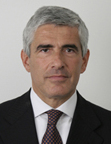| | First party | Second party | Third party |
|---|
| |  |  |  | | Leader | Silvio Berlusconi | Dario Franceschini | Umberto Bossi |
|---|
| Party | People of Freedom | Democratic Party | Northern League |
|---|
| Alliance | EPP | S&D | EFD |
|---|
| Leader since | 18 January 1994 | 16 February 2009 | 4 December 1989 |
|---|
| Last election | 32.4%, 25 seats | 31.1%, 24 seats | 5.0%, 4 seats |
|---|
| Seats won | 29 | 21 | 9 |
|---|
| Seat change |  4 4 |  3 3 |  5 5 |
|---|
| Popular vote | 10,797,296 | 7,999,476 | 3,126,915 |
|---|
| Percentage | 35.3% | 26.1% | 10.2% |
|---|
| Swing |  2.9% 2.9% |  5.0% 5.0% |  5.2% 5.2% |
|---|
| | | Fourth party | Fifth party | Sixth party |
|---|
| |  |  |  | | Leader | Antonio Di Pietro | Pier Ferdinando Casini | Richard Theiner |
|---|
| Party | IdV | UDC | SVP |
|---|
| Alliance | ALDE | EPP | EPP |
|---|
| Leader since | 21 March 1998 | 18 January 1994 (as CCD) | 18 April 2009 |
|---|
| Last election | 2.1%, 2 seats | 5.9%, 5 seats | 0.5%, 1 seat |
|---|
| Seats won | 5 | 5 | 1 |
|---|
| Seat change |  5 5 |  0 0 |  0 0 |
|---|
| Popular vote | 2,450,643 | 1,995,021 | 143,509 |
|---|
| Percentage | 8.0% | 6.5% | 0.5% |
|---|
| Swing |  5.8% 5.8% |  0.6% 0.6% |  0 0 |
|---|
|






